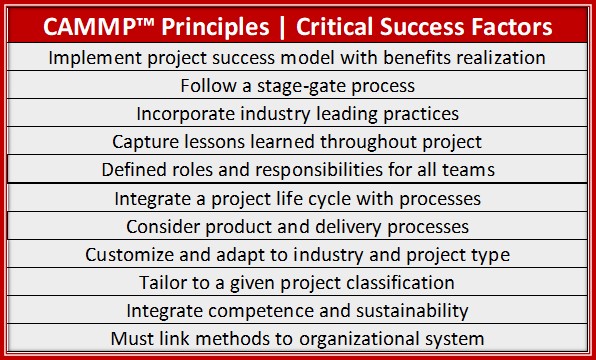Recently, we have published on LinkedIn the CAMMP eleven principles or critical success factors. These are the principles necessary to build tailored project management methods in organizations. These tailored methods are for the management of projects and delivery of products. An online network connection (Mr. Larry Moore) raised the question: “Could you please explain just what you mean by “product and delivery processes?” Are these two different and separate groups of processes, or are they combined into a single set of processes? ”
So, what are the differences between product-oriented processes and project management processes? Further, why is it important for project managers to know about both? That is what we are answering in today’s article.

CAMMP
For those who are new to our blog site and SUKAD, CAMMP stands for The Customizable and Adaptable Methodology for Managing Projects™. It is a project management and product delivery methodological approach that we developed initially in 2007. The CAMMP Principles we list here are per CAMMP version 3. We documented this version via a CRC Press (Taylor & Francis) book, titled: Project Management beyond Waterfall and Agile.
The CAMMP Principles
It is essential to reflect on what are these CAMMP Principles. We developed these principles as the critical success factors for applying project management in the real world. In other words, these are the principles professionals must consider as they translated generic guides into a fit-for-purpose OPMS. OPMS stands for the Organizational Project Management System. Therefore, an OPMS would include tailored methods, among other things.
Gaps in published project management guides
When we consider some of the published project management guides, such as those from ISO, PMI, and others, we notice a fixation on the project management process. This fixation or focus is understandable since these processes are across industries. However, product-oriented processes are not mentioned at all, or these guides mention them but do not address them. We do realize that these product-oriented processes AND project life cycles vary from one industry to another.
The problem with the above is:
- When these guides ignore the product-oriented processes, professionals start to think of “pure project management,” which means those other processes are not my business.
- It also creates a culture that managing a shed in a backyard is the same thing as leading megaprojects.
- Alternatively, it leads to thinking that the project manager must be a technical expert. This is common in business and technology projects where the PM is often a technical lead rather than a PM.
The project management process box
Now, the whole idea behind these principles is APPLYING; applied project management. Therefore, practitioners should not limit their thinking to the Box (Guides). I know all guides say that we should not, but it is amazing how many put their head in the box and do not see anything else.
In other words, to apply project management, we need to know what is in the Project Management box. Also, we must understand that our job is to manage a PROJECT but to deliver a product. Therefore, we must realize the need for product-related processes. Saying it differently: look into the box but consider what is outside the box.
Product-oriented processes
What are the product-related processes?
We start with tailored methods, based on a project life cycle that is fit-for-purpose for the type of project, size, and complexity.
Then we need the industry experience to know what processes are needed and when they should take place along the project life cycle.
The project manager is not expected to be an expert in these things but must understand their importance.
For example, in the process (industrial) projects industry, we have something called Inherent Safety Reviews and HAZOP. A project manager does not have to be a process engineer to lead this work but must know they must happen. Further, a project manager should also ensure they are done in a quality manner. Therefore, these reviews or actions could be called product-oriented processes; or industry best practices, etc.
Industry segmentation
Closing this article, we must emphasize that an organization must have fit-for-purpose OPMS. Then, the OPMS would include tailored methods. These tailored methods are built on customized project life cycles, which we use to manage product delivery. Further, the tailored methods would consist of product-oriented processes. Consequently, these product-oriented processes, along with the project management processes, would be necessary for leading projects concept to success. Hence the need for these CAMMP Principles.
Finally, and as a result of the above, one can conclude the following. Project Management in the purist form is generic. Estimating process is needed for all types of projects. However, how to estimate might be influenced by the project domain (industry, type, size). Consequently, we need project managers to understand how to take a project from concept to success. As a result, we need more industry segmentation.

Trackbacks/Pingbacks